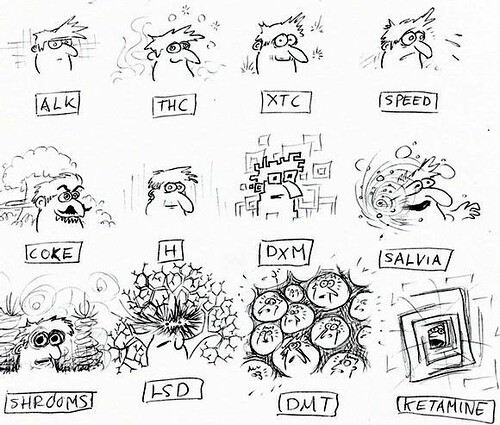By Kevin Shanks, D-ABFT-FT
Pharmacodynamics (PD) is the study of the effect of substances on the body. The word is derived from Greek – Pharmakon and dynamikos which means “force” or “power”. PD includes concepts such as receptor affinity, receptor activity, and potency.

“Whelp” by NoelMichelle. Licensed under CC BY-SA 4.0.
Receptor affinity is the measure of how well a substance binds to a receptor. As an example, let’s look at the opioids, morphine and fentanyl. Both substances bind to the mu (µ) opioid receptor. Morphine binds to the receptor with an affinity (Ki) equal to 1.8 nM, whereas fentanyl binds to the receptor with an affinity (Ki) equal to 0.39 nM. This essentially means that fentanyl has a 4-5 stronger hold at the receptor than morphine does.
Once a substance binds to a receptor, it will produce a response or effect. A substance can bind to the receptor a produce an effect – this is called agonism. A substance can also bind to the receptor and block a response from occurring – this is called antagonism. A drug such as morphine or fentanyl binds to mu opioid receptors and acts as an agonist – it produces analgesia and central nervous system depression. Naloxone, on the other hand, is a receptor antagonist as it binds to mu opioid receptors and does not produce a biological response – it blocks other opioids from binding to the same receptors.
Potency refers to the amount of a substance that is needed to produce a desired effect. To compare drug potencies, we look at the EC50, or the concentration of drug at which 50% of the maximum effect is achieved. When two substances are tested in the same person, the drug with the lower EC50 would be considered more potent. A lesser amount of a more potent drug is needed to achieve the same effect as a less potent drug.
Within the study of the pharmacodynamics of drugs, we are also concerned with the route of administration, onset of action, and duration of action.
The route of administration is the path by which a substance is taken into the body. Common routes of administration include oral (by mouth), dermal absorption, mouth inhalation, nasal inhalation, nasal insufflation, smoking, vaping, intravenous injection, intramuscular injection, intrathecal injection, sublingual absorption, buccal absorption, and rectal absorption. Tablets such as Xanax (alprazolam) and Vicodin (hydrocodone) are to be consumed orally. Cocaine can be nasally insufflated or snorted. Heroin may be injected intravenously. Methamphetamine may be smoked. Nicotine can be vaped.
The onset of action of a drug is the amount of time it takes for a drug’s effects to occur after administration. The onset is dependent on the route of administration, but there are other factors including drug formulation, dosage, and the individual consuming the substance. Substances that are orally consumed typically have an onset of action 30-90 minutes and those substances that are smoked or inhaled have onset of action typically within minutes. Substances that are injected directing into the blood stream have effects that occur within seconds to minutes of administration. As an example, when someone smokes or vapes cannabis, the effects normally occur within minutes, but when someone consumes a THC-infused edible foodstuff by mouth, the onset of action is normally 30-90 minutes after ingestion.
The duration of action of a drug is the length of time that a substance is effective or how long effects are felt. As an example of duration, morphine’s effects are typically felt for 4-5 hours after administration, while fentanyl’s effects are felt for 1-2 hours after use. As with onset of action, the duration of action can also be influenced by route of administration and formulation of drug used. Substances such as Oxycontin (extended release oxycodone) will have a duration approximately 12 hours.
The branch of pharmacology known as pharmacokinetics can help to answer questions such as ‘Are drugs involved in the incident?’ or ‘How much substance did a living individual consume?’ or ‘When was the substance taken?’, but the knowledge of pharmacodynamics can help to answer questions such as ‘During the incident, was an individual impaired?’ or ‘Was the person suffering from toxic drug effects?’ or “Did this substance play a role in the death of the individual?’.
If you have any questions or concerns regarding the role of pharmacodynamics in your toxicology case, please reach out to our Axis Forensic Toxicology subject matter experts at [email protected].
References
Guidelines for the Interpretation of Analytical Toxicology Results. Disposition of Toxic Drugs and Chemicals in Man. Twelfth Edition. Randall C. Baselt. Biomedical Publications. Pages xxx-xlii. (2020).
Pharmacokinetics and Pharmacodynamics. Principles of Forensic Toxicology. Fourth Edition. Barry Levine. American Association for Clinical Chemistry (AACC). 2017. 77-93.
Introduction to Forensic Toxicology. Clarke’s Analytical Forensic Toxicology. Sue Jickells and Adam Negrusz. Pharmaceutical Press. Pages 1-12. (2008).
Postmortem Toxicology. Clarke’s Analytical Forensic Toxicology. Sue Jickells and Adam Negrusz. Pharmaceutical Press. Pages 191-218. (2008).
Postmortem Forensic Toxicology. Principles of Forensic Toxicology. Fourth Edition. Barry Levine. AACC, Inc. Pages 3-14. (2017).
